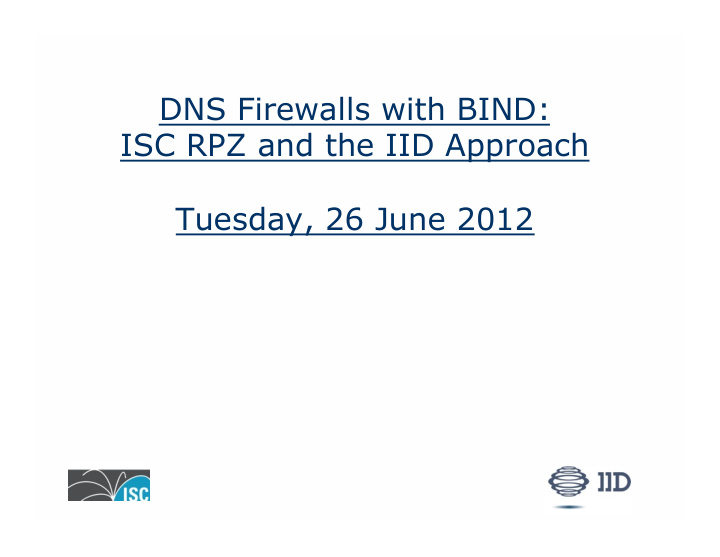



DNS Firewalls with BIND: ISC RPZ and the IID Approach Tuesday, 26 June 2012 1
About the Presenters » » » Paul Vixie Rod Rasmussen Chairman and Founder President and CTO Internet Systems Consortium IID (Internet Identity) 2
Logistics • Webinar is 1 hour long • A recording will available in 3 business days at http://www.isc.org/webinars • Participants are muted • Use the Q&A Tab to submit questions 3
Agenda • Building DNS Firewalls with RPZ – Paul Vixie • DNS Firewall – Rod Rasmussen • Q&A Session 4
Building DNS Firewalls With RPZ Paul Vixie Internet Systems Consortium 5
DNS firewalls • A DNS firewall examines responses to queries, passes some, blocks others. • Responses can be “examined” for any content. • “Block” action can discard, modify, or replace the original response. 6
The hard part • The essence of a DNS firewall is simple. • What’s hard? Maintenance. • How to provide the data that guides its behavior? • How to update that data easily? • How to share that data with others? 7
More about RPZ • DNS firewall rules carried inside DNS zones. • Rules published, subscribed, shared by normal DNS zone transfer protocol – Including IXFR, NOTIFY, TSIG. – So, propagation is timely, efficient, and authentic. 8
RPZ inspection capabilities • If the name being looked up is X. • If the response contains any IP address in range X. • If a listed name server name is X. • If any returned name server IP address is in range X. 9
RPZ action capabilities • Synthesize NXDOMAIN. • Synthesize CNAME. • Synthesize NODATA. • Synthesize an answer. • Answer with the truth. 10
Implications • Controlled Balkanization. • Open market for (many) producers and (many) consumers. • Differentiated service at a global scale. • Instantaneous takedown. 11
Status • RPZ is open and unencumbered. • Implemented only in BIND (so far). • Performance reasonable (~15%). • New features backward compatible. • ISC standard not an IETF standard. • We hope for other implementations. 12
DNS Firewalls Rod Rasmussen IID (Internet Identity) President and CTO 13
Critical Internet Security Problems • Malware command-and-control • Malware infection sites • APT attacks • Phishing and spear phishing 14
Solution • DNS Firewall • Over 80% of malware uses DNS to communicate. Using a DNS firewall is an easy way to stop this. • Network professionals and security pros working together for mutual benefit 15
• Leverages “big data” on Internet security events to create intelligence that prevents enterprise employee and system connections to known malicious Internet locations • IID identifies and takes down thousands of malicious Internet locations a week • Brings in data feeds and works with hundreds of global law enforcement, security vendors, security researchers • Instantly alerts SOC/NOC of problems on enterprise networks via unique “TrapTrace” feature 16
Collective Intelligence • Latest actionable intelligence on malicious Internet locations • Share findings from unique customer relationships – one of the best networks around • Aggregates many of the most robust threat intelligence streams in the industry 17
Feed Delivery • Real-time threat updates via RPZ push capability • Daily pre-determined malicious domains • Feed empowers your own DNS infrastructure to provide robust security network wide with no new overhead 18
TrapTrace • RPZ redirection enables enterprise security personnel to instantly be notified when a compromised machine tries to: • Access a command-and-control server • Transmit sensitive data to a known drop zone • Connect to spear phishing site 19
Use Cases: Malware and APT Attacks • Malware command-and-control • APT attacks 25
Summary • Over 80% of malware uses DNS to communicate. Using a DNS firewall is an easy way to stop this. • IID provides solution with actionable intelligence via RPZ feeds and unique TrapTrace feature • By bridging gap between network administrators and security professionals, DNS firewalls are protecting real customers against real threats • IID and ISC are ready to help 26
Take Action • Go to www.internetidentity.com/solutions/ activetrust-resolver • Email dnsfirewall@internetidentity.com 27
Questions
About IID Trust IID to proactively protect against the latest cyber threats: • Five of the top six banks in the U.S. • Largest government agencies worldwide • Leading financial services firms, e-commerce, social networking and ISP companies Headquartered in Tacoma, Washington www.internetidentity.com 29
About ISC • Non -profit dedicated to Internet infrastructure • Software: BIND9, (BIND10,) ISC DHCP, … • Operations: F-Root, Hosted@ISC, … • Protocols: about two dozen IETF RFC’s • Policy: Internet governance (e.g., SOPA) • Commercial services: – support, training, feature development – registry services for new gTLD’s – DNS hosting (public-facing or “secondary”) 30
• ISC • IID • www.isc.org • www.internetidentity.com • info@isc.org • info@internetidentity.com • +1 650 423 1300 • +1 253 590 4100 31
Recommend
More recommend